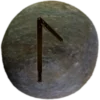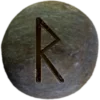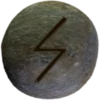Last Updated on February 12, 2025


Hrund (pronounced “Hroond,” with a rolled “r”) appears as a Valkyrie in Norse mythology. Her name likely comes from the Old Norse word hrund, meaning “wave” or “flow.” Scholars suggest this links her to the movement of battle, like a tide washing over warriors. Some sources list her name as Hrundr, but Hrund remains the most common form. ![]()
The Nafnaþulur, an appendix to Skáldskaparmál in Snorra Edda (The Prose Edda), includes Hrund in a list of Valkyries. This means poets knew of her, though no known myths describe her deeds. Like many Valkyries, Hrund likely chose slain warriors for Odin’s hall, Valhalla.
Hrund’s name suggests a connection to the chaos of battle. Warriors may have seen her as a force guiding the fight’s ebb and flow. Some scholars compare her to Valkyries like Hrist (“Shaker”) or Hjörþrimul (“Battle Noise”), both linked to the battlefield’s movement. If her name means “wave,” Hrund could symbolize the flood of warriors rushing into combat.
Icelandic sagas and skaldic poetry often describe Valkyries as both fierce and otherworldly. Hrund’s presence in the Nafnaþulur suggests poets knew her name well enough to include her among Odin’s shieldmaidens. While she does not appear in major sagas, she stands alongside other lesser-known Valkyries who still shaped the myths of warriors.
Valkyries often served mead in Valhalla, reinforcing their dual role as both battlefield spirits and caretakers of the slain. If Hrund had a similar role, she may have been both a harbinger of death and a guide to fallen heroes.
Runes Linked to Hrund
Laguz (ᛚ) (pronounced “LAH-gooz”) connects to Hrund’s possible meaning of “wave.” This rune represents water’s movement, adaptability, and hidden depths. Battle tides rise and fall like the ocean, just as Hrund’s name suggests.
Raido (ᚱ) (pronounced “RYE-thoh”) symbolizes journeys and movement. Valkyries travel between worlds, guiding fallen warriors. Hrund, as a force in battle’s flow, mirrors this Elder Futhark rune’s meaning. ![]()
Her Importance to Asatru
Hrund holds significance for Asatruar who honor the Valkyries. Her name suggests she influences the unpredictable flow of battle. Warriors may look to her for guidance, seeking her favor in conflicts both physical and personal.
Asatruar who embrace warrior traditions see Valkyries as divine figures of honor. Hrund, like her sisters, represents fate’s hand in life and death. Her presence in poetic tradition shows the deep respect Norse people held for these battle-maidens.
Some Asatruar honor Hrund in rituals for strength and courage. She stands as a reminder that battle, like the sea, follows its own course.


